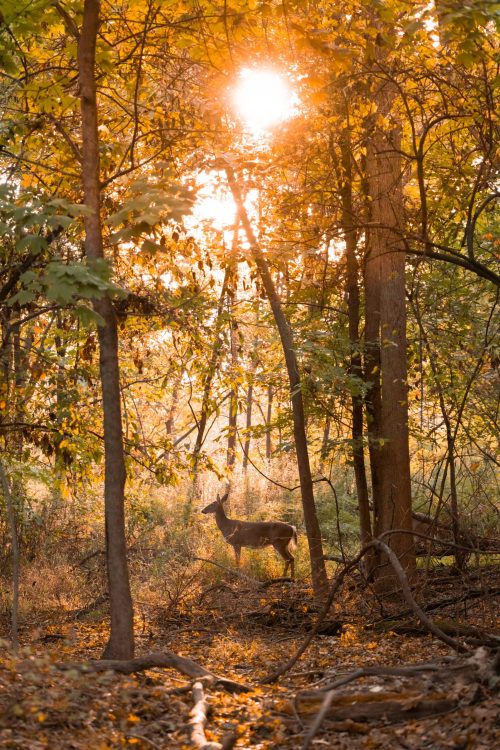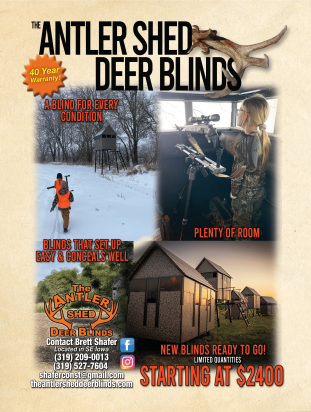Whitetails 365: Summer Hunter’s Checklist

Whitetails 365: Summer Hunter’s Checklist
For most Iowans, this time of year is time for barbecues, swimming pools, and lazy afternoons. But for a hunter, our brains are keyed in on hunting, and we’re continuously thinking about how we can improve our land and get ready for deer season 2025. Use this time as a period of preparation, observation, and strategic planning that lays the groundwork for a successful season. It’s a chance to get ahead of the game, fine-tune your strategy, and ensure you’re ready when opening day rolls around. So, grab your boots, slap on some bug spray, and let’s dive into the summer hunter’s checklist.
Checking and Maintaining Your Stands
Tree stands are my favorite way to hunt, but they can also be a significant safety hazard if not properly maintained. Climb up (carefully, of course!) and check every inch of the stand: the platform, the supports, the straps, the ladder – everything. Look for signs of wear and tear: rust, rot, frayed straps, loud squeaks. Replace anything that looks questionable. I’m a firm believer in replacing my straps every single year, no exceptions. It’s cheap insurance against a potentially disastrous fall. I also hate noisy stands, so, you can add in rubber and plastic washers to keep your stands quiet.
While you’re up there, take a look around and do some trimming. Those small branches that seemed insignificant during the season can become major obstructions once the leaves fill out and will continue to grow. A little pruning now can make a big difference later. Clear out any brush or small trees that could obstruct your view or your shot. A clean shooting lane can make the difference between a successful hunt and a missed opportunity. Do this now while the vegetation is less dense and the weather is cooperative.
While you’re out, if you happen to stumble upon some morel mushrooms while you’re at it, well, that’s just a bonus!
Deciding Where Your Stands Should go
Summer’s mild weather makes it ideal for moving tree stands and setting box blinds. It’s not too hot, you’re not battling mosquitos and flies, and you have plenty of time for the deer to acclimate to the new locations before the season starts. Think strategically about where you want to position your stands. Are you trying to intercept deer traveling to feeding areas? Are you focusing on known bedding areas? Consider prevailing winds, terrain features, and the deer sign you’ve observed in previous seasons.
Moving stands also gives you a chance to reassess your hunting area. Are there any new trails you’ve noticed? Has the habitat changed significantly? Sometimes, a slight shift in stand placement can dramatically improve your odds.
Water is Key
Water is essential for all wildlife, especially during the hot summer months. Take a look at your property’s water sources. Are they adequate? If not, consider creating some new water holes adding another task to your summer hunter’s checklist. Creating a reliable water source for wildlife can be approached in several ways. Some hunters opt for a simple excavation in a low-lying area, using a tractor or skid loader to dig a hole that will naturally collect water.
A black stock tank can be used too as a pond, either buried, semi-buried, or placed above ground. For buried or semi-buried tanks, lining the bottom with gravel or stone creates a more natural appearance.
Maintaining these water sources requires a strategy for replenishing the water. A nearby spigot solves your problems. For buried tanks in low-lying areas, natural runoff can provide a source of water, but it’s important to be aware that debris and dirt will also accumulate. If you choose to bury a tank to collect runoff, be extra careful to prevent mineral contamination. I consulted with the DNR on this issue, and they advised that adding minerals to the water or positioning the tank downhill from a mineral site could classify the water as “bait.” While minerals and additives can be used, hunting over water containing them can be considered baiting. Always familiarize yourself with local laws and regulations to ensure compliance.
Minerals and Monitoring
Minerals play a crucial role in antler development. Summer is the time when bucks are starting to put on inches, so it’s a good idea to supplement their diet with mineral blocks or other mineral supplements. May is one of the biggest months for growth, so having a high-protein source that has plenty of calcium and phosphorus as well as other macro and micro nutrients will set them up to pile on the inches of antler for this fall. They’re also my favorite place to get photos of deer. You seem to have just about every deer coming in at some point.
While you’re at it, check your trail cameras. Make sure they have fresh batteries and are functioning properly. Trail cameras are invaluable tools for monitoring deer activity, assessing antler growth, and taking inventory of which bucks have made it through the previous season. Use the data you collect to refine your hunting strategy and focus on the areas with the most promise.
Check & Maintain Food Plots
Food plots are a great way to attract and hold deer on your property. For the summer hunter’s checklist, summer is the time for food plot maintenance. If your spring food plot failed, move to a warm-season food plot, like sorghum, or you can still plant some alfalfa. Check your plots for weeds and spray or mow them if necessary.
If you want an extra boost, you can fertilize the plots. Some hunters prefer fall food plots, and for a good reason. They’re one of the best when it comes to attracting deer through the hunting season. So, you may want to plan your fall food plot. You might need to look at your equipment, consider upgrading or any maintenance and get ready to use it in a couple of months. A well-maintained food plot can be a magnet for deer, especially during the fall when natural food sources become scarce.
A Final Word of Advice
Summer scouting is more than just checking off a list of tasks. It’s about immersing yourself in the woods, observing the subtle changes in the environment, and developing a deeper understanding of the deer you hunt. It’s about anticipating their movements, understanding their habits, and putting yourself in the right place at the right time. So, get out there, explore your hunting area, and enjoy the beauty of the summer woods. Your hard work now will pay off handsomely come hunting season. And remember, safety is always paramount. Let someone know where you’re going, carry a first-aid kit, and be aware of your surroundings. Happy scouting!
May 15, 2025



